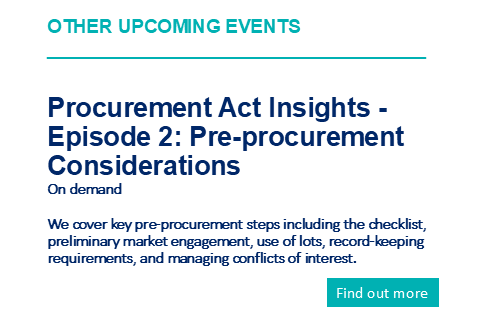- Details
Key updates to the Administrative Court Guide
Olivia Dawson and Jonathon Blunden highlight for practitioners the key amendments in the latest edition of the Administrative Court Guide.
The Administrative Court Guide (“Guide“) provides detailed guidance on judicial review proceedings in the Administrative Court, summarising relevant case law, the Civil Procedure Rules (“CPR“), and supporting practice directions. Whilst the Guide does not have legal force, it is “required reading” for all involved in judicial review proceedings. The Guide is now in its ninth edition (2024). New text in the Guide is indicated by underlined text.
Reply to the Acknowledgement of Service
Paragraph 8.5.1 of the Guide has been replaced with the following text:
“CPR 54.8A permits a Claimant to file a reply to an acknowledgment of service. A reply must be filed within 7 days of service of the acknowledgment of service….”
It had long been the practice for claimants to file a reply following receipt of a defendant’s acknowledgement of service, despite no provision in the CPR permitting a claimant to do so. Following changes to the CPR, with the insertion of a new CPR 54.8A (effective from 6 April 2024), claimants are now permitted to file a reply. New paragraph 8.5.1 reflects this.
However, whilst this provides reassurance that a claimant is expressly permitted to file a reply, paragraph 8.5.1 continues by cautioning:
“A reply should only be filed where it is considered necessary to assist the court in determining permission where, for example, the acknowledgment of service raised a discrete point that was not addressed in the claim form. A reply should not be used to rehearse matters already referred to in the claim form. A reply should be as concise as possible and should not exceed 5 pages. If a Claimant seeks to file a reply which exceeds 5 pages, the court’s permission will be required…”
If a reply is deemed necessary, it is important to keep it concise and confined to true reply points. Otherwise, there is a risk that the court may make a costs (or other relevant) order against a claimant (see also CPR 54A PD, paragraphs 7.1-7.2).
Duty of Candour
The importance of the duty of candour is “impossible to overstate” and, where breached, “it is inimical to the rule of law”: R (Saha) v Secretary of State for the Home Department (Secretary of State’s duty of candour) [2017] UKUT 17 (IAC) at [47]-[48]. This principle has been reflected in previous iterations of the Guide, and the latest edition reinforces this, incorporating new points from recent case law.
First, the Guide includes the following new text at paragraph 15.1.3:
“Where a party relies on a document, and the document is significant to the decision under challenge, it will be good practice to disclose the document rather than merely summarise it, because the document is the best evidence of what it says.”
This reiterates the ‘best evidence’ principle identified by Fordham J in R (Police Superintendents’ Association) v The Police Remuneration Review Body and Anor [2023] EWHC 1838 (Admin) at [15]. Full and candid disclosure will ordinarily require disclosure of the actual document – summaries, selected quotations, or descriptions are likely to be inadequate.
Second, paragraph 15.5.3 of the Guide has been revised to state:
“Parties should consider carefully whether the text being redacted is genuinely irrelevant. Text which explains the provenance and context of a document, such as the name of the sender, recipients or copy recipients of a document (even if these are junior officials or external contractors), and should not be redacted as a matter of course. Without this information, it may be more difficult to understand the significance of the document. It will usually be permissible to redact contact details (e.g. email addresses) if that is thought to be useful.”
The Court of Appeal’s judgment in R (IAB and Ors) v Secretary of State for the Home Department and Anor [2024] EWCA Civ 66 confirms that parties to judicial review proceedings are not entitled to redact the names of junior officials purely on the basis of relevance. The principle also extends to “external contractors”, reflecting Swift J’s judgment in R (IAB and Ors) v Secretary of State for the Home Department and Anor [2023] EWHC 2930 (Admin) at [31].
Third, the Guide sets out further redaction guidance in a new paragraph 15.5.4:
“A party disclosing a redacted document should explain the reason for that redaction at the point of disclosure. The explanation need not be elaborate and should be such as to afford the receiving party a sensible opportunity to decide whether to apply for disclosure of the unredacted document. The provision of single word explanations, such as “relevance” or “privilege” will rarely be sufficient. Documents should never be filed or served in an edited form without making clear that they have been edited. When redacted documents are exhibited to a witness statement the reason for redaction may be given either in that statement or a separate witness statement. If the redaction is made on grounds of legal professional privilege the explanation should be given in a witness statement made at the solicitor with conduct of the case.”
This revision expands on the 2023 version which had stated:
“Where a redacted or edited document is included in evidence, the fact that redactions have been made, and the reasons for them, should be made clear, preferably on the face of the redacted document.”
The updated Guide confirms that the disclosing party must provide, at the point of producing a document, sufficient explanation of the reason for applying any redactions. This imposes a greater duty on the disclosing party to provide an explanation for redactions, which goes beyond single-word explanations on the face of the redacted document. Swift J’s judgment in R (IAB and Ors) v Secretary of State for the Home Department and Anor [2023] EWHC 2930 (Admin) at [43]-[44] is cited as authority for this proposition.
Finally, the Guide no longer includes the following text:
“If a party wishes to redact [text which explains the provenance and context of a document, e.g., the name of the sender or recipients of an email] from a disclosable document, an application should be made to the Court for permission to do so, explaining the reason for the redaction, where necessary with supporting evidence.”
This confirms that “it is not open to parties to judicial review claims to attempt to contract out of these obligations” through, for example, consent orders: see R (MTA) v Secretary of State for the Home Department and Ors [2024] EWHC 553 (Admin) at [26].
Interim Relief
Paragraph 16.6.1 of the Guide includes new text relating to mandatory orders:
“When considering whether to grant interim relief while a judicial review claim is pending, the judge will consider whether there is a real issue to be tried and whether the balance of convenience lies in favour of granting the interim order. Where the relief sought is a mandatory order against a public body, a strong prima facie case needs to be shown…”
De Falco v Crawley Borough Council [1980] QB 460, 461, which was approved in R (RRR Manufacturing Pty Ltd) v British Standards Institution [2024] EWCA Civ 530 at [87] and [112], is cited as authority for the proposition that a “strong prima facie case” needs to be shown for the grant of a mandatory order against a public body. This threshold must be met in addition to the balance of convenience test.
Filing Documents
Paragraph 7.8.10 of the Guide states:
“E-filing will be introduced to the Administrative Court in September 2024. E-filing allows court users to issue and file documents, pay court fees and review and track their cases online. E-filing cannot be used for applications in which urgent consideration is sought and these applications should be lodged using the procedure as set out at section 17 of the ACO Guide. The ACO website will provide E-filing guidance for court users and should be referred to by court users when filing claims using this method.”
E-filing is due to be introduced imminently – practitioners should keep a close eye on the Administrative Court Office (“ACO“) website for further guidance.
The Guide confirms that parties can no longer file documents by fax, except when instructed by the ACO or a judge (paragraph 7.8.9). Previous editions allowed fax filing in urgent cases. Practitioners should now follow the updated guidance for hard copy and electronic filing (paragraphs 7.8.2-7.8.11).
Remote Observation of Hearings
The Guide includes a new Annex 7 which sets out guidance for making an application to observe hearings remotely. Practitioners should take note that it is in the judge’s discretion as to whether to permit remote observation of a hearing and if an application is granted, the applicant must comply with the conditions imposed by the judge and any further instruction by the judge during the hearing.
Closed Material Procedure
The Administrative Court can make a declaration for a closed material procedure under section 6 of the Justice and Security Act 2013. Closed material is relevant information that, if disclosed, would be damaging to national security. The Guide includes a new paragraph 19.3.17, outlining methods for altering closed material to make it suitable for disclosure as an open document:
“There are various ways in which a document containing closed material may be rendered suitable for disclosure as an OPEN document. The CLOSED material can be redacted by blacking out various parts. The part of the document that does not comprise CLOSED material can be re-typed in a new document, indicating with gaps, or ellipses, or other markers where text has been omitted (the “plain paper” version). A new document can be created which contains the gist or a summary of the CLOSED material. When either of the latter approaches is adopted, this should be made clear.”
The Guide cites R (L1T FM Holdings UK Limited) v Secretary of State in the Cabinet Office [2024] EWHC 386 (Admin) at [6] as authority for this approach.
Olivia Dawson is an Associate and Jonathan Blunden is a Partner at Sharpe Pritchard LLP.
For further insight and resources on local government legal issues from Sharpe Pritchard, please visit the SharpeEdge page by clicking on the banner below.
This video is for general awareness only and does not constitute legal or professional advice. The law may have changed since this page was first published. If you would like further advice and assistance in relation to any issue raised in this article, please contact us by telephone or email
|
Click here to view our archived articles or search below.
|
|
ABOUT SHARPE PRITCHARD
We are a national firm of public law specialists, serving local authorities, other public sector organisations and registered social landlords, as well as commercial clients and the third sector. Our team advises on a wide range of public law matters, spanning electoral law, procurement, construction, infrastructure, data protection and information law, planning and dispute resolution, to name a few key specialisms. All public sector organisations have a route to instruct us through the various frameworks we are appointed to. To find out more about our services, please click here.
|
|
OUR RECENT ARTICLES
December 10, 2025
Sharpe Pritchard appointed to £60m London Boroughs’ Legal Alliance frameworkSharpe Pritchard, one of the UK’s leading public law firms, has been re-appointed to the London Boroughs’ Legal Alliance (LBLA) Solicitors Panel.
November 20, 2025
Strengthening the standards and conduct framework for local authorities in EnglandJames Berry offers his insight into how the proposed changes to standards and conduct rules will affect local authorities.
November 04, 2025
Procuring and operating open frameworks under the Procurement Act 2023Chantelle Pink offers advice to authorities on open frameworks and how to procure them.
October 31, 2025
Building Solar – 5 Top Tips for Solar Farm Construction ContractsSolar farm construction contracts are in focus following fascinating insights into the continuing global uptake and expansion of renewables, and particularly solar, within the 2025 mid-year report of Ember, a global energy think tank.
|
|
OUR KEY LOCAL GOVERNMENT CONTACTS
|
||
|
Partner 020 7406 4600 Find out more |
||
|
Partner 020 7406 4600 Find out more |
||
|
Rachel Murray-Smith Partner 020 7406 4600 Find out more |







 Catherine Newman
Catherine Newman
